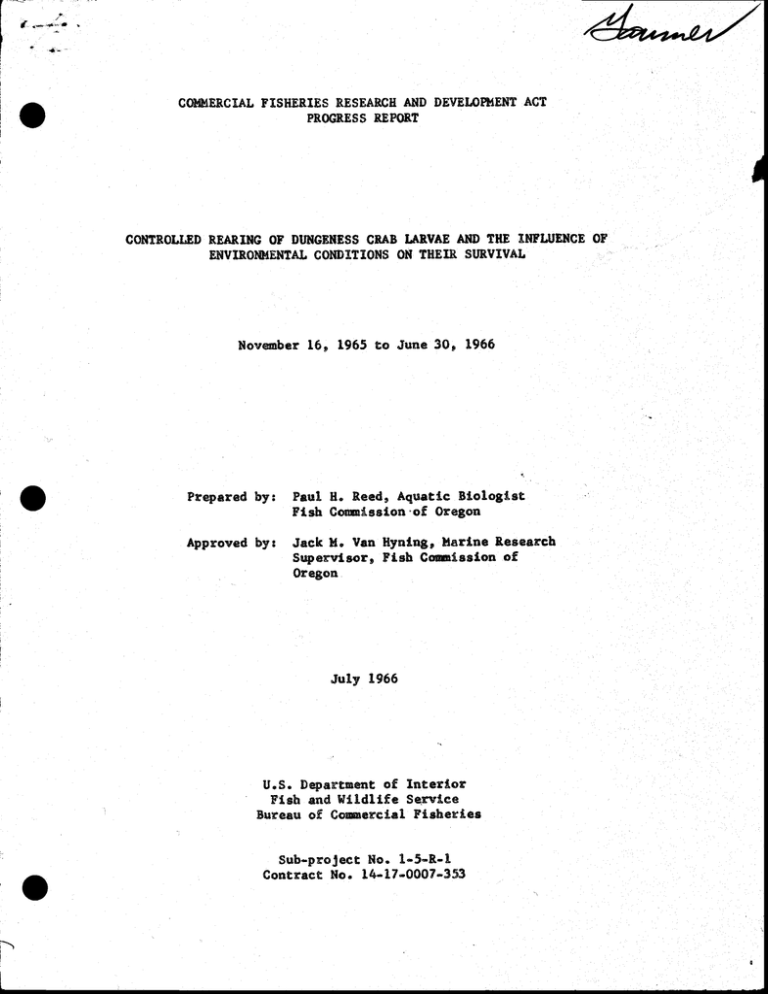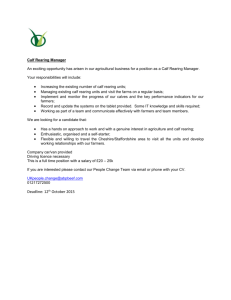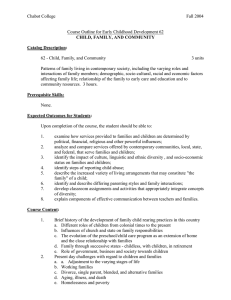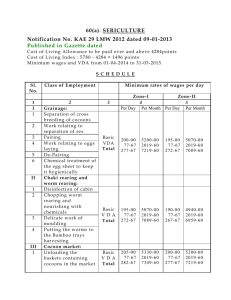I
advertisement

g .*,-.al'r
.
-.- -
ACT
COMMERCIAL
FISHERIES
AND DEVELOPMENT
ACT
AITD
DEVEIOffiET{T
RESEANCE
COMUERCtrAI,
FISHEBIESRESEARCH
REPORT
PROGRESS
REPORT
PROCRESS
I
THFLUEilCEOF
OF
AND THE
TTTEINFLUENCE
CONTROLLED
REARING
CRAB
IARVAE AND
DUNGSNSSS
COITTROLT,ED
REARI}ICOF
CNABLARVAE
OT DUNGENESS
ST'RVIVAL
ENVIRONMENTAL
CONDITIONS
ON
THEIR
SURVIVAL
OH THEIB
ENVIROIiIMENTAL
CONDX,TtrONS
1966
November
16, 1965
1965 to
to June
June 30, 1966
Novober 16,
Prepared
Prepered by:
by:
Bl,oLogdst
H. Reed,
Reed, Aquati,c
Aquatic Biologist
Paul H"
Oregon
Fish
of Oregon
F{sh Coemission
Cosmfseton'of
Approved by:
Approved
byr
Researcb
Jack
H. Van
Marine Research
Vaa Ryning,
Hynlngo Harl,ne
Jsck U,
Supervisor, Fish
of
Ftsb Coeeiission
Sarpervlaoro
Co{,sEton of
Oregon
Oregoa
July 1966
1966
July
Interior
Department of
of Interior
U.S. Dqart8ent
Fish end
and !{{,l.dltfe
Wildlife Service
Segvi,ee
Flsh
Fisherf,ee
Bureau
Bureau of
0cmersial Fisheries
of, Comzercia1
gu$-proJect No.
Sub-project
Ho. l.5.ft-1
1-5-R-1.
Contract No.
No. Ur-17-0007-353
1447.0007-353
Coatract
-
INTRODUCTION
INTRODUCSTON
.
rearing
devel.opuent of
of rearing
Construction of
Construetloo
and development
larvel rearing
rearlng system
syst€D and
of a larval
ftrst
of, the
the first
techniques
were the
eechnl,ques for
the objectives
obJectlves of
for Dungenese
Dtngeness crab
lanrae rer€
erab larvae
progrrn.
year's
vearrs program.
l,lterature
oearchl consultation
coneultetlon
Preliminary work
work involved
a literature
search,
Prellnlnery
lavolved e
ytth biologists
larval culture,
*ad
culture, and
with
blologl.ete involved
cnrstrcesn larval
rlth aolluscan
and crustacean
lnvo!,ved with
@llusean and
norkers"
conteryoraty workers0
of contemporary
the
deslgn of
rearl.og system
the design
of, a rearing
on the
the success
stlcceea of
based on
system based
MATERIALS
ND METHODS
USTEODS
UATERIALSAITD
(Flgures 1I
A
requlred and
csnstaucted (Figures
A semi-closed
wes required
and constructed
rearlng system
sen!,-ctrosed rearing
systcm was
throqgh aa
Ebe system
Sea
water from
Yaquina Bay,
enters the
systm through
Sea water
Bay, Oregon, enters
f,rm Yaqulua
and
2).
and 2).
ulttaan ultrapae-systcm! filter,
passes through
second filter,
flteers an
pre.system
head tank,
tank, aa second
fll,tern passes
througb aa head
velveso
aeedle valves.
violet unit,
vi.olet
untte and
tbro$gh needle
and eaters
enters ten
lucubetors through
tea incubators
Used
Used sea
ees
or discarded.
dlscard€d.
reef.rculated or
water
sater drops
drops into
lnAo aa sunp
and is
la either
elther recirculated
euqr and
S
ugter
The
removes
macroscopic matter
pre-eystem filter
nrtter from
fro the
tbe sea
Eea water
the prs-system
ftltes
rencrves Eactoacoplc
(FlSure 3).
3)"
pree1uding obstruction
€t'lter (Figure
precluding
of the
second filter
obEtructtsa of
tbe second
Sea
water falls
fslle
$ea rater
gravele
cosrsG gravel,
contaln!,ng coarse
into
stages
fllter
stag€s containing
tenk through
three filter
lnto the
the bead
bead tank
tbrougb three
gravel and
gfrcs woos,
reepetlvely.
fine
f,!.ne gravel
woolo respectively.
and glass
cleaning.
eteanlng,
f,or rapid
rapld
Each
rencvable for
ts remcvabie
Each stage
ctege is
per minute.
ga!,lons per
nlnute.
The
capacity
ftlter
ls ten
ten gallons
tle filter
cepaclty is
pertods of
of,
queltty during
durtng periods
A 750-gallon
A
a€,a-Fater quality
75O-gellon head
head tank
tank assures
essur€e sea-water
adverse
conditions and ua!,ntalns
maintains head
head for
for gravi,ty
gravity f,lor
flow to
to otber
other systcs
systm*
advease sea-water
sea-water condltloas
polyctbytreoe sheet.
sheetc
sttb aa polyethylene
components. The
tank is
ts lined
trtned with
comryroBesta.
Xhe tank
Fli,terlte
L 20 uU flt.ter
Most
filter equlpped
equipped
r€ooved by a Filterite
|lleroscople matter
Host microscopic
natter is
ls removed
with
L5 micron
nferou orion
orloa elements.
e!.mentgn
Ettb 55 or
ou 15
bacteri,e
reduee bacteria
A
unit
Ls employed
eryXoyed to
8o reduce
unit is
A Steritronic
ul.tra-vl,olet
Sterltroa{,c SWL-lO
$lfL-LO ultra-violet
levels by 99%.
lene!.a
9!tZ,
ultrathe ultraProtozoans
by the
f,woblllzed
unleel!.uner algae
atrgaa are temobilized
Protogosas and
asd unicellular
violet
v8olee light.
llght.
placed in
bath contain
coa,{tsln
Five-liter
polyethylene incubators
tn aa temperature
polyethylcne
teryet ture bath
tncubators placed
Flvc-lleer
[I:
grayE and
rater
treated sea
eea water
supply of
of, treated
suspended
reeel,ve a continuous
contlnuoua supply
rearlng trays
and receive
auspead.edrearing
I
trQy)
IncuLor net v1ves
a
0,
t:3
\e
l't
oo
.t
u -l-
Iuor
\So
(f)
-!
l-
.t-o
2:
+
{ 'j: )
Nd
as
CUH
\'__
6u,
:
aJ
Iicubtor
l!l
+J
+-
x
Nx
36comartme
I
0,
cGJ
oJ
-.rl l .
2oa
b30 m screee
d
L
-f;r o
--o
3
()
H.
d
)
4
H
o
{J
tt)
L
LTI
--
>r
a
q0
Dust cover
LI
o,
o
H
.d
!)
${
d
-to
G,
o
H
\
f,
U
g
3
a
F
m
Fl
$t
,F{
,E
:)
L)
o
Uflt
+-
.g
+
H
CD
'd
I
r.
v
.L
.tr
1;
.L
ai;
E
)
a
o
A
€
d
+)
o
(t}
b0
E
F{
<
Figure 1.
t-l.
-9
f
d
lr-
d
V
=
Turn VO.ivt.
+'
d
:,1
.r{
t0
to
_9
o
I
.;
fer
vive
I
v
G
s
rt,
/
,o
I
Art
!
.q,
o_ -l-
1
tq,
V /Ultrq-violet
Incubor oQt(et
a
tu
t
.Fl.
Fq
5
qi
.o)
SeQw&i
L)
o
t{
e/i
II
\,
o'6-
I!
(1
71
IL
I
PVC pipe-
/
t'
r{
H
3 Sct9e rrQYstm
t/|
ol
6d
o,
{-5
o
$r
'o
!t)
7=
7
+-
l.a,
.t,
/
z.
H
q,
Arrangement and Design *f the Larval Rearing System.
-
INCUBATOR DETAIL
-.o
PAUL H. REED
'TYPE SEMI-CLOSED
CRAB LARVAL REARING SYSTEM,
t""
pT-
lj
3
d
q,
rn
3.
3.
Figure
Flgure 2.
2.
The
The Larval
Reartng System
Syst,emShowing
Showlng the
Pre-system
Larval Rearing
t,he Pre-system
Ftlter,
Filter,
Head
M i c r o n Filter,
Fllter,
Ultra-violet
H e a d Tank,
T a n k , 5 Micron
Ultra-vlolet
Unit,
Sump.
Unlt, Incubating
Incubatlng Enclosure
Enclosure and
and Sump.
F i g u r e 3.
Figure
3.
Pre-system Filter
The
The Pre-system
Showlng the
the
Filter Showing
Stages.
Removable Stages.
Three Removable
4o
(Flgure 4),
(Figure
4).
eecht
25nil
nI capacity
capeclty each,
The
of 25
36 compartments
eomparsm€ntsof
rearlCIg trays,
wtth 36
The rearing
trays, with
(Ftgure 5).
5).
Nltex screen
ltcreen (Figure
bottm with
202 micron
uieron Nitex
are covered
eovered on
on the
wltb 202
the bottom
the system.
syst€n.
in the
are ten
co@partactrt8 in
are
l,ncubators and 360 individual
lndtvtdual compartments
een incubators
There
there
SeaS€3-
clrcul.tes
needle valves
valvee and
and circulates
regulated by needle
water exchange
wat,er
tneubators is
e:lchattge in
ln the
the incubators
ls regulated
eod.
opposLte top
top end.
from the
bottom end
one incubator
f,rom
of ooe
to the
the opposite
the botto
erd of
lucubator to
'lnto
feltre into
aad falls
Sea water
water from
manifold and
Lnto a coomon
conllon rnaulfold
Sea
the incubator
f,lons into
from the
lncubator flows
a 120-gallon
120-gal1on sump.
srryl.
!.e acti
acgl*
During
periods of
floet switch
$ttteh is
recireuLatl,ono a float
Durlng per!,ods
of recirculation,
head tank
tank
vated
prlrtp operation
watea to
to the
the head
returnlag sea
aea water
vaeed and
operat!.on for
for returning
and governs pump
erltch
Duringssrna8,er
see-waterrep!,aeenent
replacementtbc
thefloat
float switch
bypasstng the
bypassing
the pre-systeo
pre-systemf!,lter.
filter. Dur!.ng
overflm
tbrough an overflow
is deactlvated
deactivated and sump
water spilis
the system
systeo through
ts
out of
of the
srry rrater
sptlle out
ptpe,
pipe0
gallon-per.ainute
tmlt
The
pumptgis aa Vauton
CC-T6OA
unit rtsh
with hypalon
hypilon
Veatoa CG-T60A
ten tengallon.per-eiinute
The prry
poLyethylene sea-water
and
and polyethylene
6ca-sat€r components.
coqronents.
,.poXtAll p*pe
pipe end
and val,ves
valves are
are nade
made of
of..poly.
Al.1
(PVC).
vinyl
vlayl chloride
chlor{,de (PVC)0
bl,oeeeayed
uere bioassayed
coostructtron were
Samples
materials used
$anryles of
used in
{,n system
of all
sys8ea construction
a!.1 unaterials
poeslble sources
rl,th
of, toxicity.
torl,c{ty.
with mussel
ellalnate possible
aources of
russel larvae
lervae to
to eliminate
cry.rtnent,
rearl"ag tray
tray compartment.
During
was held
he!.d in
each rearing
ln each
Durlag operation,
opersttona one
lerva raE
oB€ larva
Frlday'
tfednesdayr and
and Friday.
Cleaning
feed!.ng was
wes conducted
every Monday,
Uoaday, Wednesday,
Gleanlng and
and feeding
eondueted every
A
calibrated
pipette was
was trsed
used to
to dlspensc
dispense food
food assuting
assuring aa ual,fom
uniform
callbrated automatic
autmatfc plpette
amount
eaeb larval
Lanral container.
eontatosr.
aaount to
to each
control sas
was aot
not ueed,
used, but
but
A temperature
eeryrereture control,
g€ryeratuf,cg and
nonl,eorlng
by monitoring
reagonsble limits
ti,utts by
temperatures
rlthl,n reasonable
and salinittes
sel!.nltlea were
rere held
held within
tfrcn sea-water
sea-reter
replet ehtng the
systen when
the laboratory
the system
the
leboratotlr sea-water
sea-rater supply
and replenishing
erryply and
quality
was acceptable.
qnratlty ras
acceptsble.
The
were cleaned
cleaned ae
as regltred3
required; af,ter
after
sere
ftltere
The system
systen filters
passed through
750
stem fllter
filter and
and trtca
twice a
a reek
week for
for the
the
gallons passed
pre-systen
750 gallons
the pre-sy
througb the
Pilterite
Fllterite filter,
filter.
nl
rom in
250 ml
A few
conttol room
l,n 250
A
f€nr larvae
uere held
lanrae were
hcld in
*n aa temperature
teryeratuae control
(f,lve per
per flask)
175 nil
Erlenmeyer flasks
nl of,
of aea
sea rater.
water.
f,laelc) containing
flaoks (five
contelntag 175
Erlemeyer
Cleaning
Gleenlag
rear{Bg system
sched$le'
of flasks
Bysten schedule.
fl.asbs and
feedtng larvae
!,anrae followed
f,ol!.owed the
tbe rearing
aad feeding
of
:
5..
5..
/
I
Figure
F i g u r e 4.
4.
Arrangement of
Arrangement
of the
the Incubating
Incubating System
System Inside
Inslde the
the
l^Iaterbath.
Covered
Covered Waterbath.
F i g u r e 5.
Figure
5.
Detail
D e t a l l of
I n c u b a t l n g Tray.
Tray.
o f an
a n Incubating
6"
RESIILTS
SRESULTS
and
tnvestl,gator posltton
of, delayed
delayed filling
of,
the prlnclp€l
Because of
ff[fug
Because
of the
principal investigator
position and
E&oe requ!,red to deaign a,ad coastnrct
trere aval!,ab!,e for eryertmenaatlon
provtded flrst
the systen,
gravld
fc
?bree seParats batches
ef,ter Uarcb 1,, 1966.
zoee crab lanrae f,or !.alttal
rearlng
Dnagelre8s.,€r8b8
hagch oa Harch 9, [966, 288 zoea nene placed {.n the rearing
the ftrst
8rm
atGqtte.
systeor btrt e very
Zoes
htgb bateh{,ag aoorta!.fty was evl.dent befsre the soea were co&lestedo
ppti teaperature
wac not
not con
coat'€!ryterature was
29 to
33 ppt;
ra4gl,ng fron
frena 29
to 33
ranging
were held
hetd at
aE salinities
salla{ttee
above 56 F rere rareo
elalmtngly
aad after
experLnent lndtcated
f{rac
5
belqt
46 F to 58 F, a.lthougb fiuctuatlons
aad ranged frm
trotlsd
Br{ne *hrlry
srese used for food.
eeur deyc less thac f0% rere allve
$urrrlvel
(Flgure
that good eirrr!,vat ras poeatble vlthoue
week of, lncubatton.
f,aceoa,
dcelnatlng factor,
as the
the decinating
Tbereforel
pooE vl,abtlf,ty
50 F and
dro,pped
6-A).
A lsGer
feedtng durlog the
of Lanvae Bas suepectQd
At 65 days
all tbe
the larnrae
larvae had
had dfed
died and oly
only felr
few
daye aLL
At
soeal stage0
fouEtb sceal
attained
the fourth
atag,€"
attal,ned the
for aa short..term
abott-t€tu
ras used
used for
[966 and
end was
A second
Apu{l 9,
9r 1966
oeeurred on
on April
A
hateh occurred
sacmd hatch
seudy of food auitabtlity"
rnakeabl,fe t€ryeratuae
The aoea were laeubated ln 200 nt gl'ase Jars ln a
bath, but overflotr
to-e e8{rertn€nt prematurely,
of an adJacemt water tsn]
Resulte 8$gg€st lluogenees crab zoea een suw{ve
seven days wtebout, food and that barnaele netpltd
f,ood for
t€talosted
of,fer EubgtanBial pro.iee
as
earty goeal ategeso
144 of
of these
tbeee
20r 1966;
The
on April
Apr!,l 20,
1,966; 144
socs on
grav{,d feuale
fepale produced zoea
flnal gravid
Tbe final
-sere
ln
flaeks in
Erlemeyer flasks
were incubated
rearing aysS€n
system and 30
30 rrere
were set
set ln
in Erlenmeyer
ln the
tbe reerlng
ineubsted in
ro@.
the
control
€otrtrol room,
Bhe tei,erature
tqreratuae
naupll,i.
fed barnacle
barnacle nauplii.
All
were Led
AlL zoea
zoea were
Temperature
Teryercture
pptr
to 33 ppt,
to 58 F and
and 32 to
and salinity
ranges
lrystem were 50 to
for the
raoges for
reardng system
tho rearing
eallolty
ond
reepectl,vety.
respectively.
ln the
c,otrollad
the controlled
!,apae incubated
!,acubated in
The
€or larvae
respect!,ve inforsation
{nforsatlon for
Ete respective
ppt,
34 ppt.
eo 34
and 31 to
temperature
was 60 to
ro@ sag
to 64
64 F and
egryreraturc room
goea inculnsuSurvival of,
of the
the zoea
Sunrlval
but
bated in
rearing syst€s
system rras
was ellght!.y
slightly be8ter
better tban
than the
the first
first att€ry8!
atteit, btrt
the rear!,ag
bated
&n the
4
70
TO
.
B
€
fi 100
*
*Bo
,!i
E@
#
F{
g
.
Traneferred
Higher Scqleaturc
Temperature
llhnsfe*zeil to
to E{.eb*
40
r{
H20
tn
$0
ct
B
&
S.
ival Pwtblc
Possible
t&,rd.w tutrlvet
nibe1iea
WttJaoutemlbnf.i@
4'
10
10
Figare
F-tgtro 66"
20
20
30
fr
40
40
50
50
60
50
Age
in Ihya
Iys
Aep f-a
70
80
80
?o
100
90
9o1m
Survival
of Teaious
Variowi lots
Lots of,
of hggucse
Dungeness Csb,
Crab IerlnOr
1rvass
SurtuEl of
iloe, Ratøhed.
288
Msreh 90
9, 3;966
1966 end
end Scasoil
ieared t{ttht
Without
288 Zoem
&t€beil !{a.roh
SourtroLt
Tempirature
Ssfroud;&sa Control;
RGerlgAUt&.nrt
Hatched Aprii
April 20,
Without
2Oo1966
L956 end
snd Reared
zoes,Uotohoti
]-44 Zöem
B.
Be 144
Dayst
25 Duye;
Rlrat 25
Temperature
Cmtrol for
for the
thc First
llle$uleuatareControl
0stnotlcd
Zóa Hatched
eerdt at
et COatrolled
No 1966
1966 end
enil Reared
April 20,
HatobettApril
C0
C " 30
n Zw
Temperature0
Teu;leuraturc"
A.
Ao
So
days
f,{rst ten
ten days
the first
40%survived
About 40%
surv{,ved the
rdas
di,seppotnctng (Figure
6-ts).
sef.[!. disappointing
was still
{Ftgure 6-B)G
bue by 25 days
but
days only
only 3.0%
10% r@al.ned.
reained
tryeratuBes
The zoea
zoea lncubateri
incubatedatathlgher
1igher
teratures
were h!,gh!.y sueeessf,ul--af,Ber a aonth of rearf,og 50% were al{,qta and hee!.th!'y
(F{,gure 6-C),
Ao ln{,tlal
slrry
!,n survl.val was expected due to eryosure to
a uew enwi.rocaeneo ?he s!.i,gtra drop fn surv!,val between 4O and 5O days nay
have been due to metenor?boeis frcm gbe f!,f,th zoea Eo the aegalops.
Af,8er
50 days vtrrtuat!.1r atrI morbelf.ty was due eo eannd.bal{sreen iroa-trart fomed
aoea by aegalops,
Bed eb*s faeeon been e!.i.nlnaued by tsola8{on,
aurvlval
&evels pay hav€ eceeeded 25% through the negal.ops stage (F{,gure 6-er doteed
ltne).
Based os! the above suec€s$p aoea Ssoo abe reer$,ng syetsa were tre$a-
feared eo hlgher rry€raeurea
reduced (Fi,gure 6-9),
sEr Ehe 25th day aad mortal!,ty sae lmedlately
Lerva& Dungeness erab have been sueeeasfuL!,y eultuted
frou ehe egg (Ftgure 7) througb flve
asea1 otages (Ftguse 8), the mega!'ops
shage {Stgure 9}, end fnto the selreneh {nscar or sedmtary
Juvenlt e erab
(F$gure trO),
trecent
by 11nited
!,lnteed success,
succcas, recent
Although
narked by
were marked
rear*ng attempts
acterySa were
AS.choughearly
eartry rearing
stageso
Resulte
veeEuses have resule€d ,,& good survtval
ehlrcugh an1 lawal
are eneouraglag ead s$s8al.a aepfrat*oas
€sr tea8a of, envlromenEaL eff,eeEe
oa !,arva3. grCIEEt! and sucvnva!, attendan8 s{th pero!.ssibl.e nortal!,By rates.
F3.ansare bei.ag foroautated for next season€ crab batetr (Oeeobea;l{arch}.
A&though ref,i.nement of, reari.ag techs,{.ques wtll
be the forsnoeg const'deratlon}
experlmeuts !.mrslvtng the ecrnblaed ef,fects of, SryeraLuae
be*ag desigaed Eo esSf,aage Sotrerasrcetlmfts
&asva3,stage.
and salr,ni,ty are
for theee fac8ors dur{ag eaeh
9.
9.
.
S
F i g u r e 7.
7.
Figure
Eyed Egg
Attachment Stalk,
Egg of
Cancer magister
wlth Attachment
Sta1k,
Eyed
of Cancer
gster with
Two
Two Weeks
Weeks Before
Before Hatching.
Hatching.
,j1
Figure
F
i g u r e 8.
B.
magtster.
C a n c e r magister.
First
Z o e a of
o f Cancer
F t r s t Zoea
10.
10.
S
S
)o
F i g u r e 9.
Figure
9.
F l g u r e 10.
Figure
I0.
Megalops
M e g a l o p s of
maglst er.
o f Cancer
C a n c e r magister.
(flrst
Seventh Instar
magister
a g l s t e r (first
Instar of
of Cancer m
sedentary
s e d e n t a r y stage).
stage).







